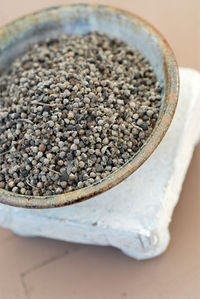Vitex agnus-castus
| See Also | Botanical Monographs |
|---|
Chaste Tree (Vitex agnus-castus) is commonly considered a women's tonic and is used to treat conditions such as dysmenorrhea, menopausal symptoms, and PMS. To explore the characteristics, medicinal uses and prescribing considerations of this herb in more detail, check out the references indicated.[1] [2]
Contents
Characteristics
- Common Names: Chaste tree, Chasteberry, Monk's pepper
- Family: Verbenaceae
- Habitat: Vitex is native to the Mediterranean and western Asia and is now cultivated world-wide in subtropical areas and is widely naturalized in these regions.
- Parts Used: Fruit
- Constituents: Iridoid glycosides, alkaloids, labdane diterpenes, flavonoids, essential oils
- Medicinal Actions: Normalizer of female sex hormones and pituitary gland function, uterine tonic (supports the corpus luteum to increase progesterone and decreases estrogen via the pituitary and FSH), galactagogue, dopaminergic agonist, emmenagogue, progesterogenic, prolactin inhibitor
Uses
Historical Uses:
Vitex was thought to reduce sexual desire and was chewed by monks to help control libido.
Medicinal Uses:
- Dysmenorrhea, PMS (especially high estrogen)
PMS, characterized by irritability and disappearance of symptoms with onset of menses, but including bloating, breast tenderness, depression, migraine, acne), menopause.
- Rebalancing after oral contraceptive use, irregular menstruation (especially with endometriosis), short menstrual cycles and heavy bleeding
- Regulation of menstrual cycle when trying to get pregnant (if infertility is related to inadequate progesterone)
- Fibroid cysts (less useful for submucous cycts), teen acne (both sexes)
- Insufficient lactation and hyperprolactinemia (elevated prolactin levels)
Prescribing Considerations
The information provided is intended to augment the treatment from a naturopathic doctor or other trained medical professional. Although most herbs are generally safe, it is recommended that you avoid self-prescribing especially when there is an underlying ongoing medical condition, if you are on any prescription medications or if you are pregnant or breastfeeding.
Formulations and Preparation
- Infusion - 1 tsp/cup infusion (10-15 minutes) three times daily
- Tincture - 2.5mL (1:5, 60%), three times daily
- Standardized extract - 175mg daily (20:1, 0.5% agnuside)
- Note: health benefits are seen after 3-6 weeks of use; treatment should be uninterrupted and last for 3-6 months
- Menopause: 2mL tincture daily for 2-3 months, especially with hot flashes
Safety
The safety and prescribing considerations for this herb include:[3] [4]
- Generally regarded as safe.
- Side-effects are nausea and headache (rare), menstrual irregularities, diarrhea, dyspepsia, acne, pruritus.
- Contraindications: pregnancy due to emmenagogue action (empirical), although it has been used to prevent miscarriage in the first trimester in progesterone insufficiency (empirical); after the first trimester it may stimulate lactation too early; spasmodic dysmenorrhea not associated with PMS (speculative); lactation (antiprolactin, speculative), although acts as a galactagogue (empirical) and has been shown to safely improve milk production (human study); depression with decreased estrogen (case report)
- Drug-Herb Interactions.[2]
- Hormone Therapy (birth control, HRT) - Vitex may interfere with efficacy of hormone therapy in women (speculative)
- Dopamine Antagonists - Vitex may weaken effect (speculative)
- Neuroleptic Medications (thioridazine and haloperidol) - Vitex may reduce its activity (speculative)
References
- ↑ Boon Heather, Smith Michael (2009) 55 Most Common Medicinal Herbs: The Complete Natural Medicine Guide Second Edition Institute of Naturopathic Education and Research, CCNM Toronto.
- ↑ 2.0 2.1 Godfrey Anthony, Saunders Paul, Barlow Kerry, Gowan Matt (2011) Principles and Practices of Naturopathic Botanical Medicine, Advanced Botanical Medicine. V3 CCNM Press, Toronto.
- ↑ Stargrove Mitchell Bebell, Treasure Jonathan, McKee Dwight L (2008) Herb, Nutrient and Drug Interactions: Clinical Implications and Therapeutic Strategies.
- ↑ Brinker Francis (1997) Herbal Contraindications and Drug Interactions: Plus Herbal Adjuncts With Medicines, 4th Edition Eclectic Medical Publications.
